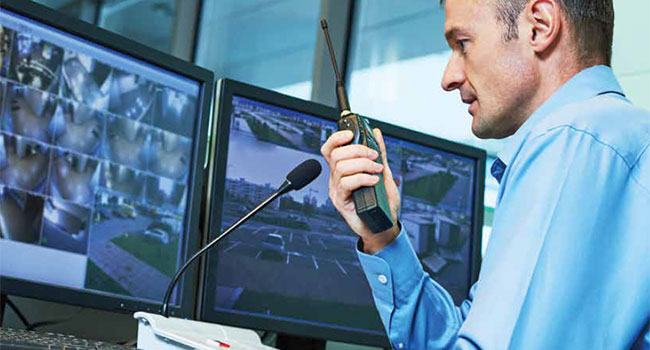
Control Room Considerations for the Campus Environment
- By Paul Reigner
- August 01, 2019
The design of a modern healthcare facility/hospital or
educational campus must take a number of factors into
consideration: parking, traffic patterns, the ability for
certain areas to be easily accessible to the public, accessibility
of rooms, protection of critical assets and people,
and much, much more. On top of all of these elements, one overarching,
critical characteristic is each building’s overall safety and
security, as well as the technology implemented to keep patients,
students, visitors, and staff safe.
Whether it’s called a command center, dispatch control, security
monitoring room or security operations center (SOC), each campus
needs a dedicated space where security officials and dispatchers can
convene in an effort to effectively respond to incidents as they arise.
The goal of any of these rooms is to monitor, assess, and respond to a
variety of threats and incidents, but there are a number of considerations
to keep in mind in crafting this environment.
Video Wall Clarity
When it comes to building an SOC, there’s a reason why large-scale
overview video walls that showcase a number of incoming data
points are dominant. Uniform and integrated visual elements are
imperative to the success of an SOC or control room in a campus
environment, as dispatchers and first responders require the most
up-to-date and complete information regarding incoming securityrelated
events.
These video walls offer a viewable area for a wide variety of devices
and data within a single pane-of-glass view, with the heart of this
mission the monitors and displays that project relevant and critical
information using strategically placed video wall technology. While
the size of these displays can vary significantly, they can also be commercial
grade, taking into account lighting conditions, location, content,
and hours of operation.
Data Generation and Storage
Almost all of the latest devices and applications are driving big data;
the amount of information available to command centers will only
continue to increase, and as analytics improve, effective data aggregation
must follow. Command centers in the campus environment
should include dashboards that can make sense of a large amount of
information and put it in a digestible format to drive streamlined
decision-making. For both this data that has been used and what
remains unused, the next crucial step involves ensuring its protection
and efficient storage. As more and more organizations turn to the
cloud for remote access and flexibility, this also creates a greater possibility
for cyber threats, which must be considered alongside physical
security in today’s SOCs.
Lighting and Temperature
There’s a lot of research that looks at the effects of ultraviolet light and
blue light on humans, citing that these kinds of lighting can cause
more fatigue. For a control room, activity must be monitored 24
hours a day, seven days a week, meaning dispatchers must adapt to
watching screens for up to eight hours a day, which can do a number
on their circadian rhythms. Installing screens that are purpose-built
to address this issue can be an important step toward building a
healthier environment for controllers.
Additionally, both lighting and equipment radiate heat at higher
levels than a normal room, so compensating for this is important to
maintain the comfort levels of the security dispatchers in a campus
setting. This can be achieved by minimizing the output of heat from
various systems by relocating them to other rooms adjacent to the
control room. Not only does this reduce the temperature, but it also
reduces the noise level in the room for easier communication between
dispatchers.
Dispatcher Line of Sight and Comfort
In many of the control rooms seen today, dispatchers have to shift
from one program to another to collect relevant information, or
only a single workstation is available for multiple people, greatly
inhibiting the ability of dispatchers to keep critical information
front and center in the event of an incident. Control room dispatchers
must be able to achieve high levels of situational awareness at
all times, which can be facilitated through the implementation of
line-of-sight considerations.
Placing monitors, computers, and consoles within reach is paramount.
Ergonomics also plays a critical role: Security control room
dispatchers must often work at a single location with minimal breaks
to field incoming alarms and monitor a facility, but sitting at a desk
for eight or more hours can negatively impact the body. Implementing
an ergonomic console that takes into account eye-level information
can help keep them comfortable and alert to react appropriately
in any situation.
Technology Ease of Use
Having to sort through equipment racks or a rat’s nest of cords
to access hardwired systems poses not only a security threat but
also a hazard for users. Having a well-maintained and easy-touse
SOC can mean the difference between a streamlined response
and a missed opportunity for addressing a threat on a campus.
Integrators should make assessments based on these factors and
keep equipment organized to avoid confusion when servicing or
troubleshooting technology.
Campus environments rely on their SOC for continuity of operations,
the safety and security of students, patients, and staff, and in
times of an emergency. As risks become more severe, a complete
situational picture is necessary, leaving decision makers to look at a
SOC as a critical part of the campus’s security plan. It is therefore
important to note best practices and considerations in building such
a center. In many cases, engaging with a partner that has a solid
understanding of the needs campus environments require with
regard to control rooms is imperative.
This article originally appeared in the July/August 2019 issue of Campus Security Today.